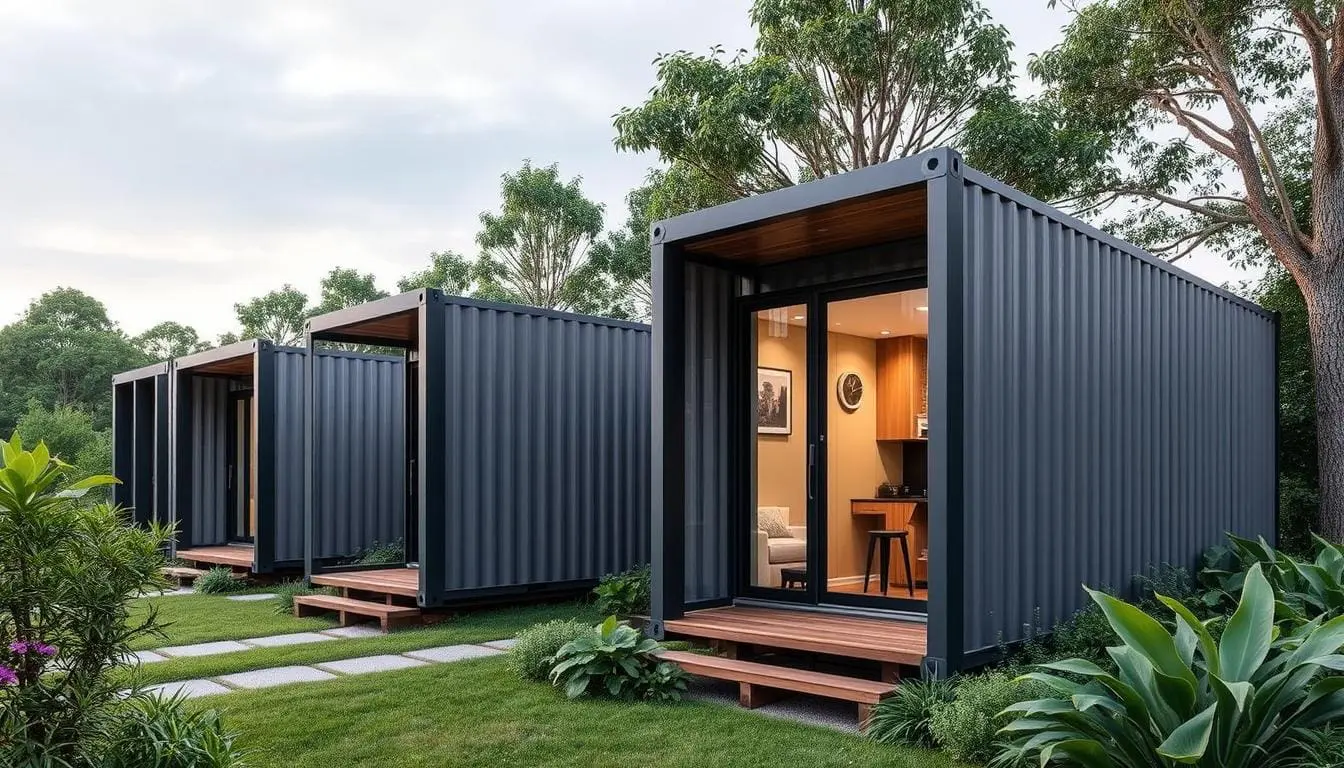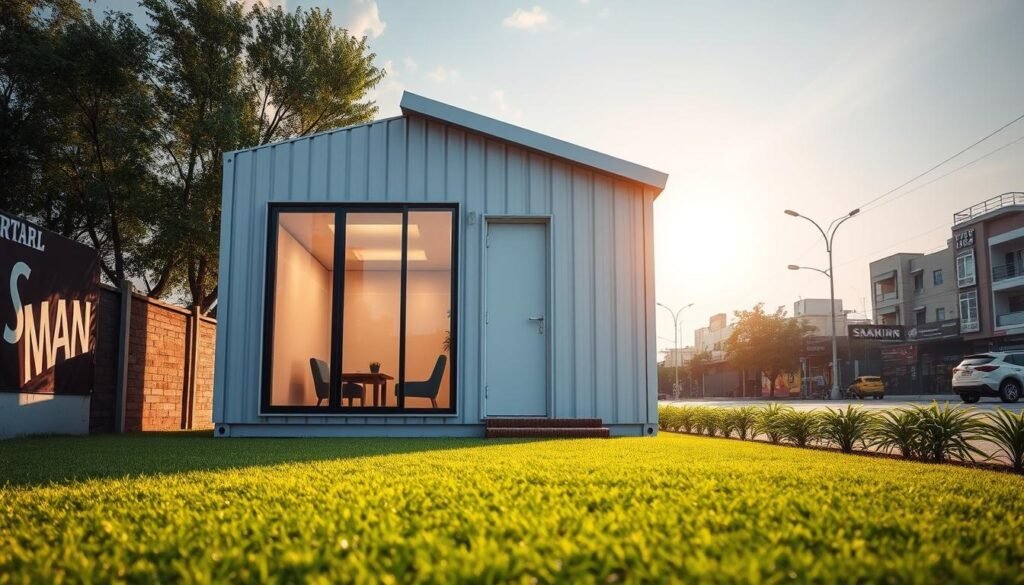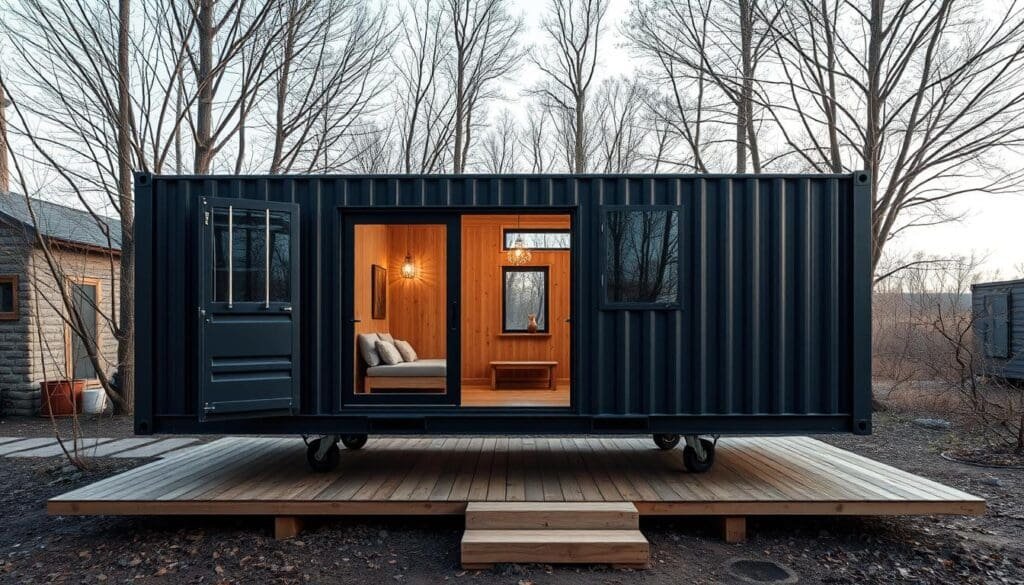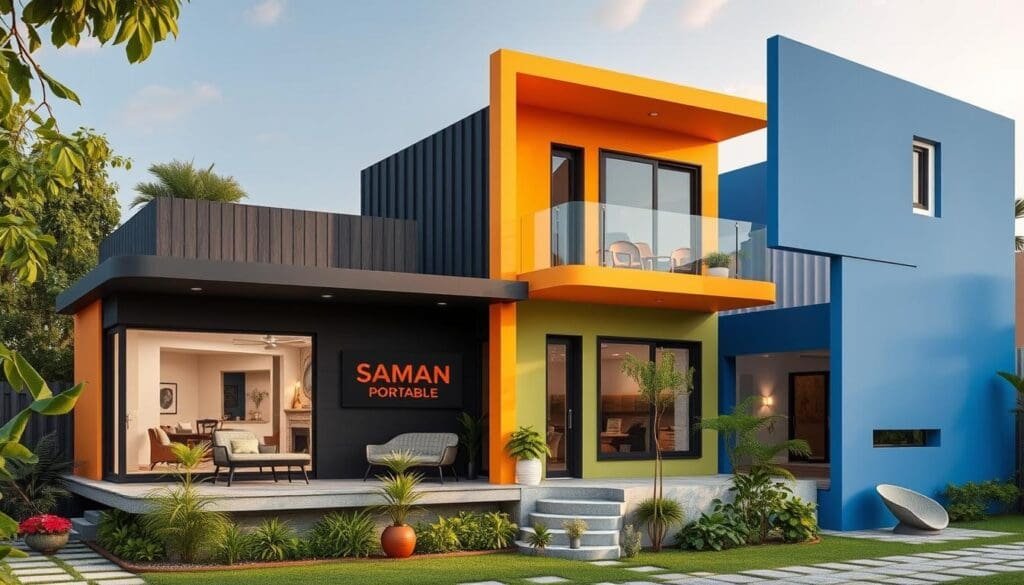Cargo Container Architecture: Innovative Designs for Modern Living Spaces

Can a simple metal box turn into a sustainable, cost-effective, and beautiful home? Cargo container architecture is changing how we see modern living. These containers, once for shipping goods, now serve as eco-friendly homes and offices.
These containers can be anything from cozy apartments to office spaces. They’re loved by designers, architects, and homeowners. Their strength, modularity, and affordability make them great for building homes and offices.
But why are people choosing this new way of building? How does it change how we live and work in our spaces?
Key Takeaways:
- Cargo container architecture turns shipping containers into innovative and sustainable living spaces.
- Shipping containers are cost-effective and quick to build, making them perfect for modern projects.
- Modular designs and flexible configurations allow for creative customization and adaptability to diverse needs.
- Cargo container homes promote energy efficiency and environmental consciousness through compact, tightly-sealed designs.
- This emerging trend is gaining traction globally, with applications ranging from residential to commercial and community-based structures.
Understanding the Evolution of Container Architecture
Container architecture has changed a lot since the 1980s. It started as a quick fix for emergency housing. Now, it’s a key part of modern architecture, offering flexible and green living spaces all over the world.
Origins in the 1980s Emergency Housing
In the 1980s, shipping containers were first used for emergency shelters. They were strong and easy to set up, helping quickly provide homes for those in need. This showed the great potential of using containers in building.
Transition to Modern Architectural Solutions
As people saw how useful containers were, they started to use them in new ways. Architects and designers began to see them as a chance to create modular shipping container office spaces and modern homes. They explored the unique looks and uses of site offices, mobile cabins, portable structures, and prefab offices made from containers.
Global Adoption and Growth
- Shipping containers can be stacked up to 12 units high when empty, and a 12-meter-long container weighs over 3,500 kilograms (7,700 lbs).
- Container structures often require the use of cranes or forklifts for transportation and construction, as they are designed to withstand heavy loads.
- The global adoption of container architecture has seen the rise of iconic projects, such as the Seventh-Kilometer Market in Odessa, Ukraine, covering 69 hectares of land and employing 1,200 security guards and maintenance workers.

The change in container architecture has changed how we see and use these structures. It has led to new ways of living, working, and solving environmental problems in cities and rural areas.
Sustainable Benefits of Container Home Construction
Container home construction is becoming more popular. It uses old shipping containers, reducing waste and saving resources. These homes also have eco-friendly features, meeting the need for green living.
Container homes are very durable. They can handle tough travel, lasting longer than many buildings. This means they don’t need to be replaced or fixed often, which is good for the environment.
- These homes can have solar panels and systems to collect rainwater, making them even greener.
- Because they’re modular, they can grow or move easily. This saves resources and avoids waste.
- Using old shipping containers means less wood and concrete are needed. These materials harm the environment more.
Learn about the benefits of shipping container houses, which do more than just save the planet. They also change how people live. They attract those who care about the environment in India and worldwide. This makes them a smart choice for today’s homes.

The field of container homes is growing. New designs and tech will make them even better for the planet. By choosing these homes, people and businesses can help the environment and enjoy unique benefits.
Cargo Container Architecture: Core Principles and Practices
Cargo container architecture uses standard shipping containers and makes necessary changes. These changes turn them into portable offices, cabins, and more. They offer new ways to live and work.
Standard Container Specifications
Shipping containers are usually 20 or 40 feet long. This size is great for building designs. It makes moving and adding to projects easy.
Structural Modifications and Requirements
To make containers into homes or offices, changes are needed. This includes cutting for windows and doors, making walls stronger, and adding insulation. These steps help meet building codes and keep people comfortable.
Design Integration Methods
Designers mix containers with other materials to create unique spaces like a container office cabin. This way, they can make the most of portable offices, cabins, and more. It lets them be creative and practical.

Following these principles, portable container offices are a green and affordable option. It works for homes, offices, and more. It’s a flexible solution for many needs.
Innovative Living Space Configurations
Container architecture is all about being versatile. It ranges from small single-container homes to big multi-container houses. These designs use shipping containers in creative ways to make living spaces that are both unique and useful.
The Zen Cube House is a great example. It’s simple and peaceful. On the other hand, the Beach Box by Andrew Anderson is perfect for beach life. It has an open layout, big windows, and smart storage to use every inch of space.
Container homes often have clever layouts that make the most of space. They offer both comfort and style. The design of these homes, including prefab porta cabin designs, features open layouts, natural light, and smart storage. This turns industrial materials into modern homes.

The Caterpillar House is a home made from 12 shipping containers. It shows how you can create a big, modern living space. The Stow-Away Hotel in the UK is even more impressive. It stacks 25 containers to make a five-story building with a cool geometric look.
These examples show how container cabins, portable workspaces, and transportable cabins can change modern living. Architects and designers are exploring new possibilities with container architecture. They’re making homes and buildings that are both functional and stylish.
Transforming Industrial Materials into Modern Homes
Prefab structures and modular shelters have changed how we live today. Shipping containers, once for cargo, now build homes. These homes are stunning and sustainable.
Material Selection and Treatment
Choosing the right materials is key for comfy container homes. Steel containers need special care to keep warm and dry. Insulation like spray foam and wool helps keep the home cozy.
Insulation Solutions
Insulation is vital for energy-saving homes. Spray foam and double-glazed windows are popular. They keep the home warm or cool without using too much energy.
Interior Finishing Options
Turning containers into homes means more than just the structure. You can choose from many finishes to match your style. From simple to fancy, these homes can be anything you want.

Turning shipping containers into homes shows the creativity of architects and builders. They pick the right materials, use smart insulation, and add stylish finishes. This way, they make these industrial pieces into homes that are both beautiful and functional.
The Rise of Vertical Container Living
Vertical container living is becoming more popular as people look for new ways to live. It stacks modular cabins or portable buildings from old shipping containers. This creates tall structures that use land well, especially in crowded cities.
These prefab cabins are good for the planet and save space. They’re perfect for areas where land is scarce.
Living in stacked containers lets people get creative with their homes. Designers are making unique layouts and adding rooftop gardens. This makes living in small spaces both stylish and functional.
Projects like Proxy in San Francisco’s Hayes Valley show how it works. It turned shipping containers into shops and a beer garden. This shows how containers can transform unused areas into lively spaces.
More and more, people are choosing modular cabins and prefab homes. Stacking them up is becoming a key way to use land in cities. It’s a smart, green way to build homes for the future.

Commercial Applications and Business Spaces
Container architecture is changing the game in the business world. It offers flexible, affordable solutions for many industries. This includes everything from new startups to big companies.
Container Offices and Workspaces
Explore top container office designs as container offices and workspaces gain popularity. They provide adaptable and efficient spaces for businesses. These modular container offices can be set up, moved, and customized easily.
The Box Office building in Rhode Island, USA, is a great example. It uses 32 shipping containers to offer different office sizes. This meets the needs of various businesses.
Retail and Pop-Up Stores
Retailers are using container architecture for pop-up stores and unique shopping experiences. The Freitag Store in Zurich, Switzerland, is a perfect example. It’s made from stacked shipping containers.
These portable and eye-catching structures let retailers try out new locations. They also offer innovative ways to connect with customers.
Educational Facilities
The education sector is also benefiting from container architecture. Shipping containers are being turned into flexible learning spaces. This is especially true for temporary or quickly needed classrooms.
The Dunraven School Sports Hall in London, England, is a great example. It was built in just 12 weeks. This shows how fast and efficient container-based construction can be.
Container architecture is versatile and meets the changing needs of businesses, retailers, and schools. It offers cost-effective office spaces, innovative pop-up stores, and adaptable learning facilities. Containers are changing how we think about commercial and business spaces.

Iconic Container Projects Worldwide
The world of mobile cabins, portable structures, and prefab offices has seen a big change. Shipping containers are now key in creating new architectural ideas. Many container projects around the world have become famous, showing how creative these materials can be.
The 2022 FIFA World Cup Stadium in Qatar is a great example. It was built from 974 shipping containers. This project shows how big and strong container architecture can be. It also changes how we think about building stadiums.
The Caterpillar House in Chile is another example. Designed by Sebastián Irarrázaval, it looks like it’s part of the landscape. It shows how modern living can fit well with nature.
The Flying Box in France, by Philippe Starck, is playful and practical. It shows that container homes can be beautiful and useful. It challenges old ideas about what houses should look like.
These projects inspire us to think differently about building with shipping containers. They show the endless possibilities of container architecture. They encourage designers and builders to keep exploring what can be done with these materials.

From the FIFA World Cup Stadium to the Caterpillar House and the Flying Box, these structures show the power of containers. They prove that shipping containers can be turned into amazing, useful, and green living spaces. These spaces catch the eye of people all over the world.
Design Considerations for Container Homes
Designing container homes is all about creating spaces that are both functional and beautiful. It involves adapting to the climate and making the most of the available space. Every detail matters in making a container home a success.
Climate Adaptation Strategies
Insulation, ventilation, and sometimes green roofs are key to keeping container homes cool or warm. These strategies help maintain a comfortable living environment, no matter the weather. By using energy-efficient designs, these homes can also be kind to the planet.
Space Optimization Techniques
Container homes have limited space, so making the most of it is essential. Using furniture that serves more than one purpose and smart storage solutions helps. Open layouts also play a big role in making these homes feel spacious and modern.
Aesthetic Integration
Mixing the industrial look of containers with modern design is vital. Exterior finishes, landscaping, and the placement of windows and doors can make a big difference. This careful integration ensures that container homes look great and fit right in with their surroundings.
In summary, designing container homes is about finding a balance between function, comfort, and beauty. By focusing on these key areas, architects and designers can create amazing relocatable cabins, temporary cabins, and modular offices. These spaces meet the needs of today’s homeowners and businesses.

Cost Analysis and Budget Planning
Container architecture is all about cost analysis and budget planning. Portable site offices, prefabricated cabins, and mobile offices from shipping containers are often cheaper than traditional buildings. But, the costs can change a lot based on design, needed changes, and finish quality.
The main things that affect the budget are the cost of containers, getting them to the site, preparing the site, making structural changes, adding insulation, finishing the inside, and hooking up utilities. Also, builders and homeowners need to think about local building codes and permits, which can increase costs.
Even though container homes might cost more upfront, they can save money in the long run. They use less energy and need less maintenance than regular houses. This makes them a good choice for those looking to save money but still want a unique home.
To plan your budget well, knowing the costs of different containers is key. A 20-foot container usually costs between ₹80,000 to ₹1,20,000. A 40-foot container is more, from ₹1,50,000 to ₹2,50,000. More special containers, like refrigerated ones, can cost even more, from ₹2,50,000 to ₹4,50,000.
By thinking about these costs and making a detailed budget, you can make sure your container project goes smoothly. This way, you can get the most out of your investment.
When planning your budget, remember to include the cost of getting the containers to your site. This can change based on shipping routes and fees. Things like fuel price changes, exchange rates, and port handling fees also play a part in the total cost.
To save money on shipping, you can try negotiating rates, combining shipments, and using containers efficiently. Understanding the costs well is key to a successful container project.
Environmental Impact and Sustainability Features
Container cabins, portable workspaces, and transportable cabins are changing architecture. They offer sustainable and eco-friendly solutions. These structures are transforming modern living and business spaces.
Container architecture is great for reducing waste and saving resources. It uses repurposed shipping containers, which are plentiful. This approach helps the environment and supports a sustainable future.
- Container homes often have solar panels and rainwater systems. They also use energy-efficient appliances.
- They use recycled and eco-friendly materials for interior finishes.
- Green roofs, like in the WFH House in China, add natural insulation and support biodiversity.
Container structures are easy to expand or move. This reduces the need for new construction and its environmental impact. Their adaptability makes them a popular choice for sustainable living and business.
The world is moving towards environmental responsibility and sustainable living. Container cabins, workspaces, and cabins are leading the way. They show how design can help preserve the environment. Architects and designers are creating a more sustainable future, one building at a time.
Legal Requirements and Building Codes
Understanding legal rules and building codes is key for container architecture projects. Laws vary by location, so knowing zoning rules, safety standards, and permits is crucial. This applies to both container homes and modular shelters.
Zoning Regulations
Zoning laws can be a big challenge for container architecture. Some places ban prefab structures or modular shelters. Others need special permissions or variances. It’s important to check local zoning laws and work with authorities to meet their guidelines.
Safety Standards
Container homes and shelters must follow strict safety rules like regular buildings. They need to be strong, safe from fires, and meet occupancy rules. Following the International Residential Code (IRC) and International Building Code (IBC) is vital for safety.
Permit Requirements
Getting the right permits is a big step in building prefab structures and shelters. You’ll need to submit detailed plans and show you follow local codes. Working with experts can make this process easier and keep your project on track.
Even though legal and regulatory rules can be tough, many places are starting to accept container architecture. By staying informed, working with local authorities, and following safety rules, you can overcome these challenges. This way, you can bring innovative living solutions to life.
Modern Amenities Integration
Adding modern comforts to modular cabins and prefab homes is key. Designers must blend essential features like plumbing, electrical wiring, and HVAC units. They do this without losing the unique look and feel of these homes.
To make the most of small spaces, designers choose compact appliances and smart storage. Even luxury homes might have high-tech features like entertainment systems and smart lighting. These add-ons turn these homes into cozy retreats.
- Innovative designs in shipping container architecture demonstrate the marriage of sustainability and style seamlessly
- Creative design and strategic planning ensure structural integrity and legal compliance in multi-story container homes
- High-end amenities and bespoke features like pools and home cinemas transform container homes into indulgent sanctuaries
Designers mix modern comforts with sustainable building to meet today’s needs. This creates homes that are both high-tech and eco-friendly. It shows how modern homes can be both stylish and sustainable.
Maintenance and Longevity Considerations
Container offices, temporary shelters, and site offices are becoming more popular. Keeping them in good shape is key. Shipping containers are tough, but they need care to last long.
Checking for rust, water damage, and structural issues is important. Using protective coatings and insulation helps avoid corrosion and moisture. This makes containers last longer and saves money on upkeep compared to regular buildings.
- Inspect for rust, dents, scratches, and moisture regularly
- Clean off visible dirt and surface rust to prevent further deterioration
- Lubricate cargo door hinges and replace weather stripping as needed
- Check plumbing ports, drain lines, and electrical connections annually
- Monitor containers for settling and re-level as necessary
With the right care, container homes and offices can last as long as or longer than traditional buildings. They are a durable and green choice for housing or business.
Following a regular maintenance plan helps container structures last a long time. They offer a strong alternative to traditional building methods.
Conclusion
Cargo container architecture is a big step forward in modern building. It offers sustainable, versatile, and cost-effective solutions for homes and businesses. It started with emergency shelters but now includes fancy designs like the Caterpillar House and the Flying Box.
This trend is getting bigger, especially in India where people want mobile cabins and portable structures. It’s changing how cities look and making living more sustainable.
The future of container architecture is exciting. It’s getting better with new designs, technology, and care for the environment. It can handle tough weather, cut down on waste, and offer prefab offices that save money and can be customized.
This new way of building is set to change how we live and work. It’s already making a big impact in India, where people are looking for new, green housing options. With its success and ongoing improvements, it’s set to change our built environment in big ways.
FAQ
What are the key benefits of container architecture?
Container architecture is great for the planet. It uses old materials, cuts down on waste, and adds green features like solar panels. Containers are also strong, flexible, and save money.
How have shipping containers evolved from emergency housing to modern architectural solutions?
Shipping containers were first used for emergency housing in the 1980s. Now, they’re used for homes and businesses all over the world. Designers are finding new ways to use these containers in modern spaces.
What are the core principles and practices of cargo container architecture?
Container architecture uses standard containers and makes them work for homes or offices. This means cutting out windows and doors, making walls stronger, and adding insulation. It’s all about making these containers into useful spaces.
How do container homes offer innovative and flexible living space configurations?
Container homes can be small or big, depending on what you need. They often have open layouts and big windows for light. Plus, they have smart storage to make the most of every inch.
What are the key considerations in transforming shipping containers into modern homes?
Turning containers into homes needs careful planning. They’re made of steel, so you need to keep them warm and dry. You can make them look simple or fancy, all while making them cozy and useful.
How is vertical container living gaining popularity as a space-saving solution?
Stacking containers is a smart way to use space, especially in cities. You can build homes or offices up high. These designs are creative and can even have gardens on the roof.
What are some of the commercial and business applications of container architecture?
Containers are good for businesses too. They make great offices or stores because they’re easy to set up and cost less. They’re also good for schools, especially when you need a place fast.
How do container homes address environmental concerns and sustainability?
Container homes are good for the planet. They use old materials and can have green features like solar panels. They’re also easy to move, which helps the environment.
What are the key legal and regulatory considerations for container architecture projects?
Building with containers needs to follow local laws and codes. This includes zoning rules and safety standards. It’s important to work with experts to make sure everything is okay.
How are modern amenities integrated into container homes?
Adding modern comforts to container homes is key. This includes plumbing, electricity, and even smart home tech. Designers use space wisely and high-end homes can have fancy features too.
 Container Cafe
Container Cafe



























































































